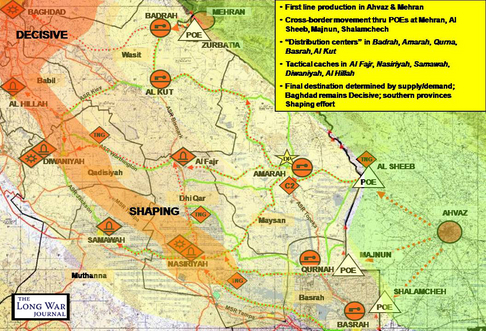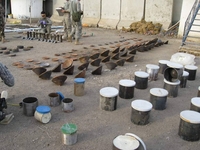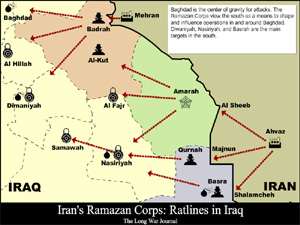|
A US military map of Iran’s operations inside southern Iraq. This 2007 map formed the basis of The Ramazan Corps and the ratlines into Iraq. Click to view full size. |
Iraqi troops uncovered a massive weapons cache and factory inside the northeastern neighborhood of Sadr City. The cache contained 34 of the deadly explosively formed penetrators, the weapons that are the hallmark of the Iranian-backed Shia militias. This is the third large cache found in Sadr City since Oct. 20.
The raid was conducted in the northern area of Sadr City, the former stronghold of Muqtada al Sadr’s Iranian-backed Mahdi Army. Iraqi troops from the 44th Brigade of the 11th Iraqi Army Division conducted the operation after receiving tips from residents in Sadr City.
The find is “significant as it included the machines used by the enemy to manufacture explosively-formed penetrators – the number one killer of our US soldiers,” said Lieutenant Colonel Steven Stover, the chief Public Affairs Officer for Multinational Division Baghdad.
|
EFPs, EFP cones and other materials seized in the Oct. 28 raid. Image from Multinational Division Baghdad. Click to view. |
The soldiers found 34 EFPs; 53 copper plates and 40 shaped plates, which are used for the EFP’s shaped warhead; 160 blocks of C4 explosives; and 14 107mm rockets and launch rails. Also found were three presses and a punch, machinery that is thought to be used to mill the copper plates into the cone-shaped warhead.
Since Oct. 20, Iraqi troops found two other large caches in Sadr City. A raid by troops from the 3rd Battalion, 42nd Brigade of the 11th Iraq Army Division on Oct. 20 resulted in the discovery of 61 rockets, 368 mortar rounds, 263 mortar tubes, shape charges, an IED, 32,000 rounds of ammunition, seven DSHKA machine guns, rocket-propelled grenades launchers and grenades, and other equipment.
The same Iraqi Army unit also found a large cache in Sadr City the day prior. The troops found 15 EFPs, an IED, two 72.5 mm rockets, two 64 mm rockets, numerous RPG launchers and warheads and hand grenades, and other equipment.
In all, 49 of the deadly EFPs have been found by Iraqi troops since Oct. 20.
Iraqi and Coalition forces have maintained the pressure on the Iranian-backed terror groups operating inside Iraq during the month of October. Seven Iranian-trained Special Groups fighters have been killed and 118 have been confirmed captured during raids since Oct. 1, according to numbers compiled by The Long War Journal. Iraqi forces also detained 180 “suspects” in Basrah during a sweep on Oct. 28, but it is unclear how many are considered Special Groups fighters. One of the men detained was a Pakistani.
Twenty-eight of the Iranian-backed Shia terrorists captured since Oct. 1 are members of the Hezbollah Brigades. The Hezbollah Brigades is an Iranian-backed terror group that has been behind multiple roadside bombings and rocket attacks against US and Iraqi forces in Baghdad. This group uploads videos of attacks onto the Internet.
Coalition forces have captured 16 Hezbollah Brigades operatives since Oct 21. A raid in Amarah netted an “Iranian-backed financer” and four associates. More than $50,000 and almost 12 million Iraqi Dinar (approximately $10,000) was found during the raid. On Oct. 28, four operatives, including an “administrator,” were captured during an operation in Abd ar Rahman, about four miles east of Sadr City. Another three Hezbollah Brigades were captured in Baghdad on Oct. 21.
Taking on Qods Force
Iraqi security forces are also zeroing in on Iran’s network inside Iraq. Iraqi forces have captured nine Iranian Qods Force agents and killed one since Oct. 18. Iraqi soldiers captured an Iranian “infiltrator” during a sweep in Basrah on Oct. 28. Iraqi troops killed one Iranian agent captured another during a clash in Al Kut in Wasit province on Oct. 24. Iraqi police captured three armed Iranian Revolutionary Guards Corps officers in Al Kut on Oct. 20. Border guards captured four more in Mandali in Diyala province.
US military officers believe Iran is ramping up its operations inside Iraq after its surrogates suffered a major defeat at the hands of the Iraqi military during the spring and summer of 2008. Iraqi troops went on the offensive against the Mahdi Army and other Iranian-backed terror groups in Baghdad and central and southern Iraq. More than 2,000 Mahdi Army members were killed and thousands more were wounded. The operation forced Muqtada al Sadr to agree to a cease-fire and disband the Mahdi Army.
Qods Force may also be looking to take a more active role in directing operations at the tactical level inside Iraq, a US military officer told The Long War Journal. Prior to this week, only a handful of Iranian operatives, along with a Lebanese Hezbollah leader, have been reported captured inside Iraq. The more than 3,000 Mahdi Army leaders and operatives that are said to have fled to Iran to regroup and rearm are believed to be infiltrating back into Iraq.
Background on Iran’s backing of the Shia terror groups
|
Flash Presentation on the Ramazan Corps and the Iranian Ratlines into Iraq. Click the map to view. A Flash Player is required to view, click to download. |
Qods Force has supported various Shia militias and terror groups inside Iraq, including the Mahdi Army, which it helped build along the same lines as Lebanese Hezbollah. Iran denies the charges, but captive Shia terrorists admit to being recruited by Iranian agents and then transported into Iran for training.
Iran established the Ramazan Corps immediately after the fall of Saddam Hussein’s regime to direct operations inside Iraq. The US military says Iran and Lebanese Hezbollah have helped establish, fund, train, and arm, and have provided operational support for Shia terror groups such as the Hezbollah Brigades and the League of the Righteous. The US military refers to these groups as well as the Iranian-backed elements of the Mahdi Army as the “Special Groups.” These groups train in camps inside Iran.
US and Iraqi forces have captured several high-level Qods Force officers inside Iraq since late 2006. Among those captured are Mahmud Farhadi, one of the three Iranian regional commanders in the Ramazan Corps; Ali Mussa Daqduq, a senior Lebanese Hezbollah operative; Qais Qazali, the leader of the Qazali Network; and Azhar al Dulaimi, one of Qazali’s senior tactical commanders. The US has imposed sanctions on Major General Ahmad Foruzandeh, the former Qods Force commander, and Abdul Reza Shahlai, a deputy commander in Iran’s Qods Force, for backing Shia terror groups inside Iraq.











18 Comments
If Iran is denying sending these folks into Iraq, why don’t we parade each of the Iranians captured on television, stating their name, rank, and city of residence in Farsi.
That should publicly prove that they are indeed knowingly sending agents into Iraq, killing American and Iraqi security forces. We would then publicly state that this kind of aggresion would no longer be tolerated and that any other agents captured would be viewed as an act of war. That is, that we expect that they would remove all of their agents from Iraq. Failure to do so would lead to consequences.
Then, if and when other Iranian agents are captured, they would again be paraded on television as proof of further aggression against Iraq with a reminder of the previous warning.
Again, I believe we need to publicly parade each and every one of these captured Iranian agents to prove to the world that their intentions are far from benign.
AAndrew
Talk about mopping up. And to think that only a few months ago, this area was a no-go zone.
AAndrew’s comment about public information on the Iranian subterfuge is on the money. We’ve all heard that the propaganda front is key in this war. This evidence should be broadcast to the Iranian public so people in the region grasp the danger the Al Qods’ strategy is to peace in the area. Iraqis too, will want to know about the nature of this evil.
Yes, the perpetrators should be paraded and exploited in every way.
It is frustrating–and I’m sure frustrating for coalition commanders–to have so much information about these operations yet not be allowed to attack the sources inside Iran. If the Bush administration was more aggressive about this, it would give commanders the green light to hit these rats where the supply lines start, in Iran.
That is fantastic! My son is deployed to Sadr City, and his job is looking for these devices. The less around the better. Go IA.
How can Iran deny this? I wish we could hear this new on main stream media.
The Thunder Run has linked to this post in the blog post From the Front: 10/30/2008 News and Personal dispatches from the front and the home front.
Do we know the origin of the machines?
Several months ago, I had read that the machining of EFPs was difficult and the source of the finished product had to be Iran — could not have been made in Iraq, etc. Clearly, this cannot be completely correct, with the correct machine and training.
Glad to take the machines (and all those EFP and explosives) out of circulation. Just think of the lives and property this discovery saved. Very cool!!!
I wonder how many more are out there and if any new machine shipments can be interdicted.
“Parliamentary speaker Ali Larijani threatened the US with suicide attacks in response to US incursions into Syria and Pakistan. “The US method and conduct, expressed by this aggression, will only be stopped by a clear-cut and unexpected response, whose grounds were set by the martyr Hussein Fahmida,” he said. Fahmida was a suicide bomber.”
Wasn’t this guy their Nuclear spokesman, who swore that their Nuclear ambitions were “peaceful”? And now he’s advocating for suicide bombers? Kind of takes any credibility out of the “peaceful purposes” argument, as if anyone smart enough to read this site needed any additional confirmation.
It’s comforting to know a guy who was working on nukes is advocating suicide bombers. NOT!
While I agree that publicizing captured Iranian could have some benefit, if we claim they are soldiers then it would be illegal to do so according to the Geneva Convention, but if we do not claim that they are soldiers Iran is off the hook. A nice little Catch-22.
Hi My2cents,
Could they be treated as Enemy Combatants given that they are Hezbollah or Qod’s Force? We could then confirm the source AND parade them given that they are part of an organization listed as a terrorist organization versus an army.
With all due respect to the legal handwringing about Geneva Convention rights, I submit that terrorists are outside anything defined by those honorable guidelines. Fanatics who commit indescriminate murder can hardly be protected as soldiers.
In this situation, they should count themselves lucky that they are “paraded” anyplace. If they captured someone, would they not shackle their captives in front of a camera and force them to “confess,” missing fingers and all? Then would they not “slaughter” their captives and dump the bodies on public streets? The rules of engagement do not apply here, no matter what the lawyers say.
In all honesty, everyone knows what the score is. Parading the captured Iranians in front of a camera won’t change anything on that front. What it will do is provoke a response from Iran.
I’ll defer to the commanders in theater for when the time is best to do that, thanks very much. I have no doubt that they have it penciled in somewhere 🙂
In order to be covered by the Geneva Convention, the enemy captured must conform to certain rules of warfare, among which is the requirement that they be wearing clearly identifiable uniforms to distinguish themselves from the civilian population.
Unless these Hezbollah/Qods Force members are openly wearing military uniforms in Iraq– and that hardly seems possible given their clandestine activities– they are absolutely not covered by the Geneva Convention and they are not entitled to any of its protections.
Unfortunately, this clear demarcation in the G.C. was not followed by the Supreme Court in the Hamdan case which opened the door not only to G.C. rights for terrorists but also to full, habeas corpus rights (i.e. U.S. Constitutional rights) in U.S. courts. It is baffling to think that even German prisoners of war in WWII who were imprisoned in the continental U.S. were not given the rights that the terrorists are being lavished with by the courts.
So there is little chance that the U.S. could use any captured Iranian terrorists for propaganda purposes (although the Iraqis might….)
When you consider how we have to fight with both arms and a leg tied behind our back, it is amazing what the U.S. has accomplished in Iraq and A-stan!
Regarding parading captured Iranian agents in front of cameras, who cares if it provokes a response? In 1979, our citizens were paraded in front of cameras in blindfolds, and every news network on earth showed up to film it. Did that provoke us?
Now these bastards have been caught red-handed. Why are we holding back? The story needs images for the cameras, not just press releases from Stars and Stripes. We should exploit every opportunity to humiliate and demoralize this enemy. Scholars of war have said you defeat the enemy when you crush his will to fight. I’m for crushing.
I’m sorry, but our commanders in the field are not masters of public relations, they are war fighters, and God bless them for that. Our propaganda operatives need to start earning their paychecks. Get the Iranians out in front of the cameras. Let the world see them in blindfolds.
TS Alfabet,
Excellent analysis. I dont think any thing is going to change Iranian attitude – not parading their agents, not any thing – these are the same mullahs who think a 13 year old boy is good enough to be a “martyr”.
The Iranian Govt knows that a stable and a democratic Iraq is a direct threat to the long term viability of the mullahs – with oil going even further down in price, their desperation is only going to get worse.
Good luck to the US and Iraqi troops in hunting down more of these weapons factories !
Al-Sadr needs to be eliminated. The US needs to take a play out of the old British playbook and their methods for dealing with dangerous traouble makers.all without causing WWII. In the 1950’s,with the world in danger of a nuclear war, Britian formed a super secret assination group named the 16. It was so secret, you only worked in groups of 4 and even the members knew very little about the other 3 that operate in their group.
They used 2 teams of 4 to provide intelligence and 2 teams of 4 that performed the targeted assinations, with no chance of any deaths being traced back to Britian.
The US needs to adopt the strategy of a specific targeted assination program, which IMO, will prevent larger scale wars as well as eliminate trouble makers.
The question is, does the US government have the will to get involved in a dirty business that will save American lives in the future.
Al-Sadr should have been made a martyr shortly after the Al Sadr Shi’a insurgency.
The problem with designating some one an “enemy combatant” is that it is an ill-defined category that did not previously exist. That is why the Supreme Court felt a need to intrude.
It might be better to just treat them as spies (i.e. a quick non-public trial and execution then into an unmarked grave). Incidentally, even if you can prove they are Iranians, they can still claim to be volunteers and get their home government of the hook. On the other hand, if you can tie them to an attack targeting civilians, then they could probably be tried and executed for murder.
I tried to find this story in the NYT, to no avail. I guess they only will report on EFPs that kill and maim our troops; CNN will send a video crew out to film the process and show the bloody remains. If anyone objects it’s a Bill of Rights attack!
I read TEM’s comment and have to agree. Look at who we are dealing with. Sometimes you have to make moral compromises for the greater good. The evidence should be made public, but in a way we do not compromise our tactics, op-sec. Years ago, the CIA was feared. It would be good if they were again. Wonder why the Mossad is so feared?